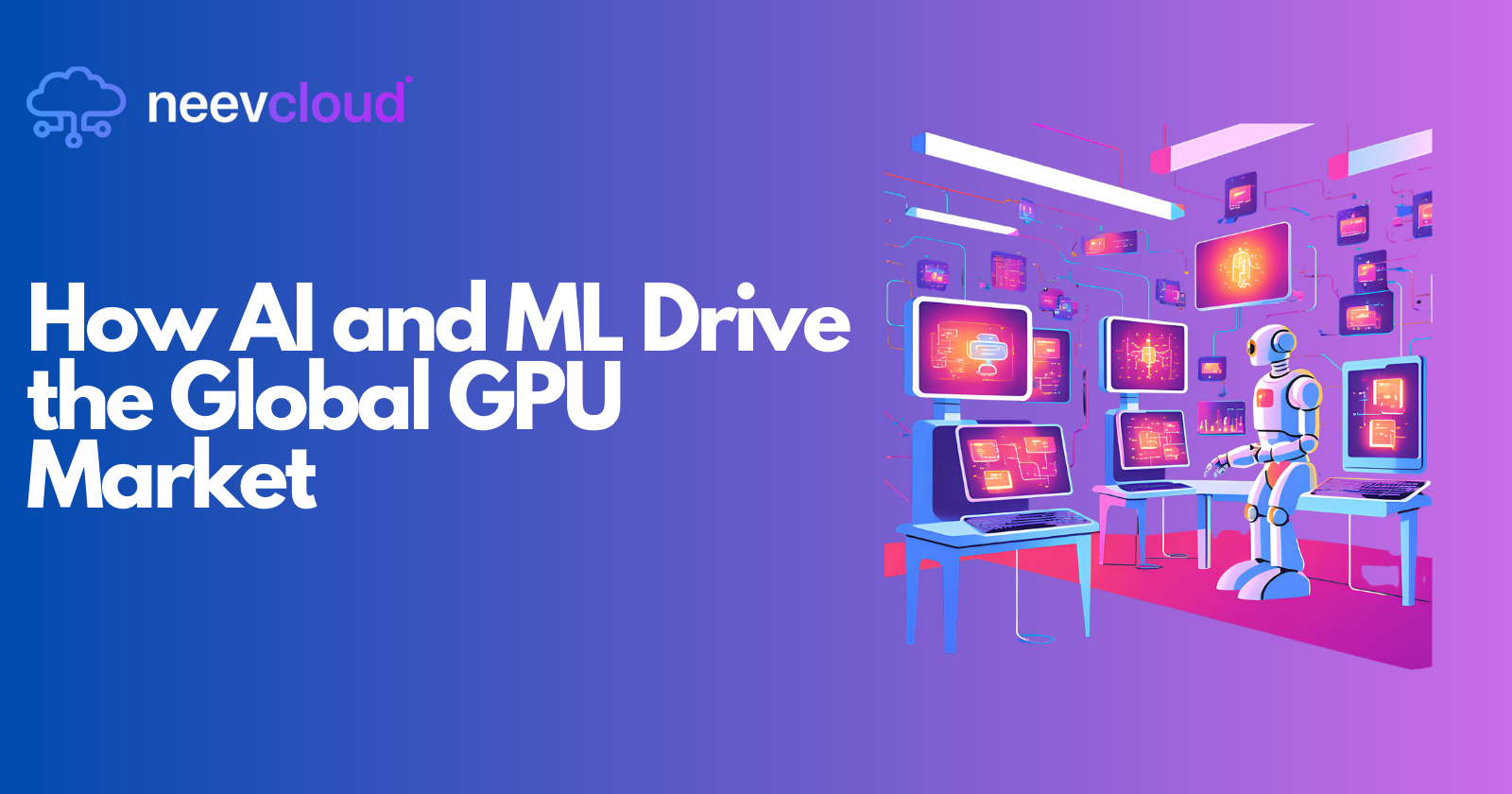How AI and ML Drive the Global GPU Market
 Tanvi Ausare
Tanvi Ausare
Introduction: The AI Revolution and the Rise of GPUs
The convergence of Artificial Intelligence (AI) and Machine Learning (ML) has unleashed unprecedented advancements across industries. From autonomous vehicles and personalized healthcare to intelligent chatbots and recommendation engines, AI and ML are revolutionizing how we live, work, and interact. However, behind these transformative breakthroughs lies a critical piece of hardware infrastructure: Graphics Processing Units (GPUs).
GPUs, traditionally used for rendering graphics in video games, have now become the backbone of modern AI Cloud, AI Datacenter, and AI SuperCloud environments. The global GPU market has experienced exponential growth, driven primarily by the increasing demand for large-scale AI/ML workloads. This blog will dive into the evolving dynamics of the GPU market, exploring how AI and ML are propelling its growth, the role of cloud computing, and what the future holds.
1. GPUs: The Core Enabler of AI and ML Workloads
AI and ML workloads are inherently parallel in nature—training models like deep neural networks involves millions, sometimes billions, of calculations performed simultaneously. Traditional CPUs, while powerful for general-purpose computing, struggle to handle these highly parallel tasks efficiently. This is where GPUs excel, offering massive parallel processing power that accelerates AI model training and inference.
Key Advantages of GPUs for AI and ML:
High Throughput: Capable of executing multiple computations simultaneously.
Optimized for Tensor Operations: Essential for deep learning tasks.
Energy Efficiency: Faster results with reduced power consumption compared to CPUs.
GPUs are indispensable for training models in computer vision, NLP (Natural Language Processing), and reinforcement learning, all of which demand immense computational resources. NVIDIA, AMD, and Intel are some of the leading GPU manufacturers driving this innovation to meet the needs of both enterprise and cloud-based AI systems.
2. AI Cloud and the Surge in GPU Demand
As organizations shift towards cloud-based AI infrastructure, there is a soaring need for high-performance GPUs in AI Clouds. Cloud service providers like AWS, Google Cloud, Microsoft Azure, and smaller players are offering GPU-powered AI Cloud platforms to facilitate on-demand training and inference of ML models.
Key Trends Driving GPU Adoption in AI Cloud:
Elastic Scaling: Businesses can spin up GPU clusters on-demand, scaling up during intensive ML workloads and scaling down during idle times.
Democratization of AI/ML: Cloud platforms allow even small startups to access the same cutting-edge GPU technology as large enterprises.
Cloud Machine Learning Platforms: Pre-configured environments like Google AI Platform and AWS SageMaker simplify deploying AI models on GPU infrastructure without the need for deep expertise.
This shift towards cloud-based machine learning lowers the barriers to entry for AI development, empowering organizations to focus on innovation rather than infrastructure.
3. AI Datacenters: Redefining the GPU Ecosystem
The rise of AI Datacenters is transforming the GPU market, as companies build specialized infrastructure to support advanced AI workloads. Unlike traditional data centers focused on general-purpose computing, AI Datacenters are optimized specifically for tasks such as AI training, inference, and data analytics.
Characteristics of AI Datacenters:
High-Density GPU Clusters: Multiple GPUs are interconnected to create powerful compute nodes.
High-Speed Interconnects: Technologies like NVLink and PCIe ensure fast data transfer between GPUs.
Energy Optimization: AI Datacenters employ liquid cooling and other advanced techniques to maintain efficiency.
These AI Datacenters cater to various industries such as finance, healthcare, automotive, and media, all of which rely heavily on AI-powered insights. For instance, financial institutions use GPU-powered AI models to predict stock market trends, while healthcare providers use them for medical image analysis.
4. AI SuperCloud: Scaling AI to New Heights
The concept of AI SuperCloud represents the next frontier of cloud computing, where AI capabilities are deeply integrated across multi-cloud and hybrid cloud environments. In an AI SuperCloud, GPUs play a pivotal role in connecting and scaling AI workloads seamlessly across multiple datacenters and clouds.
How AI SuperCloud is Changing the GPU Landscape:
Cross-Cloud GPU Workloads: AI SuperCloud enables the distribution of training and inference tasks across multiple cloud providers.
Federated Learning: GPUs in AI SuperCloud facilitate federated learning, where models are trained on decentralized data without compromising privacy.
Resilient AI Infrastructure: The SuperCloud model ensures redundancy, minimizing the risk of downtime for mission-critical AI applications.
By leveraging the AI SuperCloud approach, enterprises can harness the combined power of multiple GPU-powered environments to achieve near-infinite scalability. This trend will drive even more innovation in the GPU market as cloud providers and hardware vendors collaborate to meet the demand for seamless, cross-platform AI capabilities.
5. Key Players and Ecosystem: GPU Vendors and AI Cloud Providers
The growing demand for AI and ML workloads has fueled fierce competition among GPU vendors. Companies like NVIDIA, AMD, and Intel are in a race to develop the most efficient GPUs optimized for AI Cloud, AI Datacenter, and AI SuperCloud environments.
Notable GPU Products for AI and Cloud Machine Learning:
NVIDIA A100: Designed for heavy AI workloads with Tensor Core technology.
AMD MI250: Ideal for HPC and AI workloads with advanced AI acceleration.
Intel Gaudi AI Processors: Targeted at enterprise AI, optimized for cloud ML workloads.
Meanwhile, AI Cloud providers continue to enhance their offerings by integrating the latest GPU technology. For instance:
AWS EC2 P4 Instances: Powered by NVIDIA A100 GPUs.
Google Cloud TPUs: Custom accelerators for deep learning tasks.
Azure NV-Series VMs: Designed for GPU-powered AI training and inference.
This symbiotic relationship between GPU vendors and cloud providers drives continuous innovation in both hardware and software ecosystems, further propelling the global GPU market.
6. Challenges in the GPU Market and Future Directions
Despite the rapid growth, the GPU market faces several challenges. Supply chain disruptions, increased competition, and energy consumption concerns are some of the pressing issues. However, AI and ML trends are likely to continue driving demand, creating opportunities for innovation in the following areas:
Future Directions for the GPU Market:
Specialized AI GPUs: Emerging architectures focused exclusively on ML workloads.
Energy-Efficient GPUs: Addressing power consumption through innovations in chip design.
Quantum-AI Hybrid Models: GPUs may become part of larger, quantum-enhanced AI infrastructures.
AI-Powered GPU Management: Automated resource allocation using ML models to optimize GPU usage across AI Clouds and Datacenters.
These developments will shape the future of the GPU industry, ensuring it remains a critical enabler of AI and ML advancements.
7. Conclusion: The GPU Market at the Intersection of AI Innovation
The global GPU market is being redefined by the explosive growth of AI and ML applications. The demand for AI Cloud, AI Datacenter, and AI SuperCloud solutions has made GPUs an essential component of modern computing. As businesses and industries increasingly adopt cloud-based machine learning solutions, the need for scalable and high-performance GPU infrastructure will only grow.
GPU vendors and cloud providers must work closely to address challenges, ensure energy-efficient designs, and push the boundaries of performance. As we move into an era of ubiquitous AI, the GPU market will continue to thrive, serving as the backbone for AI-powered innovation across industries.
The AI revolution is just beginning, and GPUs are at its core—driving new possibilities and transformative solutions in our increasingly digital world. NeevCloud remains committed to staying at the forefront of these advancements, empowering businesses with the latest insights and technologies shaping the future of AI and cloud computing.
Subscribe to my newsletter
Read articles from Tanvi Ausare directly inside your inbox. Subscribe to the newsletter, and don't miss out.
Written by
